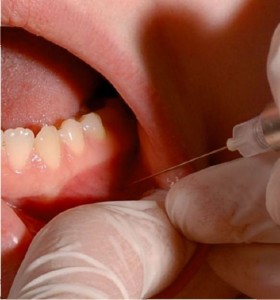Dental Implant Anesthesia

Anesthesia for dental implants is one of the important aspects of the healing process.
High-quality anesthesia is the key to physical and psychological comfort during any surgical intervention.
To date, there are several methods of anesthesia that can relieve the patient from pain and reduce discomfort during treatment.
With the help of your doctor, you can choose the most suitable method of pain relief so as not to feel discomfort throughout the entire period of implant placement. The success of the operation depends not only on the professional skills of the implantologist, the quality of the implants and equipment.
No less important is the psychological mood of the patient, especially his lack of fear of surgery.
Modern medicine adheres to the rule: anesthesia during surgery should always be reasonable and adequate.
- Adequacy of anesthesia means relieving pain to the required minimum.
- Validity means the right choice of anesthesia method for each case. In this case, the doctor uses the main principle: “do no harm”. The question is: what can be done? The fact is that severe pain sensations cause great harm to the body. But you can do harm with painkillers. The more serious the surgical intervention, the more dangerous the complications can be.
Methods
Anesthesia during implantation can be carried out in one of the ways:
- General anesthesia.
- Local anesthesia.
- Combined analgesia.
Local anesthesia
It is the most popular method of pain relief during dental implant surgery.
When using local anesthesia, only the area where the manipulations are performed is anesthetized, while the patient is conscious.
Types of local anesthesia:

- Superficial or application. The area that will undergo surgery is sprayed with lidocaine. A positive point is the lack of a syringe. The disadvantage of this method is surface anesthesia.
- Infiltration ("freezing") - is not deep enough, but one of the most common. It is carried out using an anesthetic injection. Positive aspects - good tolerance and sufficient analgesic effect. Minus - the effect of anesthesia lasts no more than an hour.
- Conduction anesthesia is ideal for bone surgeries. Pain medications are injected into the nerves surrounding the base of the teeth. This type of anesthesia allows, for example, to disable the sensitivity of a particular area of the jaw.
- Stem anesthesia is the strongest.It is introduced into the base of the skull, acting on the trigeminal nerves, blocks the jaw nerve endings.
Local anesthesia has only one serious contraindication to use: individual anesthetic intolerance.
But if allergy to Novocain is quite common, then to modern anesthetics it is extremely rare.
Pros and cons of local anesthesia
Pros:
- No pain during the implant placement procedure.
Minuses:
- May cause an allergic reaction.
- Exposure time limit.
General anesthesia

- Despite the fact that this type of anesthesia has moved to a new level, dental implantation under anesthesia is still not recommended.
- The risk of dental treatment under anesthesia significantly exceeds the risk of implantation itself.
- When using general anesthesia during an operation, during the entire period of its exposure, a constant presence of a competent anesthetist is necessary next to the patient.
Implantation using general anesthesia is indicated in cases where it is not possible to carry out it under local anesthesia.
The essence of general anesthesia is the introduction of anesthetics into the body, due to which a person is immersed in deep sleep.
The doctor during this time makes the installation of implants completely painless for the patient.
Combined pain relief
- It is an intermediate option and involves the use of any method of anesthesia with the simultaneous use of sedatives.
- Due to this effect on the body, the patient is conscious, but does not feel pain at all and is absolutely calm.
The combination of local anesthetics becomes an excellent alternative to general anesthesia, if there are contraindications to it.
Indications and contraindications
In which cases implants are implanted under anesthesia:
- In the presence of allergic reactions to local anesthetics.
- If the patient has a low threshold for pain sensitivity. When local anesthesia does not give the desired effect.
- With increased gag reflex for the presence of dental instruments in the oral cavity.
- If there is a history of hypertension and cardiovascular disease with a simultaneous combination of increased fear and anxiety before surgery.
Contraindications
Before the operation, the anesthetist finds out from the patient the various nuances of his state of health and the list of medications being taken.
It is contraindicated to install implants under general anesthesia:
- If the patient has a history of severe pathology of the kidneys and liver.
- In the case of less than six months ago myocardial infarction.
- The presence of heart failure and heart disease.
- After the infectious diseases.
- Cerebrovascular accident.
- After a stroke.
- With exacerbation of bronchial asthma.
- During an acute respiratory illness.
- In the presence of diabetes mellitus and severe diseases of the endocrine system.
- While taking certain medications, such as hormones.
- With a "full stomach." Meal should be at least six hours, and fluid - four, before the introduction of anesthesia.
- During intoxication of the patient.
Video: "Sedation - dental treatment in a dream"
Side effect
The use of general anesthesia for dental implantation is quite rare, due to the presence of possible side effects:
- Heartbeat
- Fluctuations in blood pressure.
- Total or partial memory loss.
- Laryngospasm.
- Psychomotor agitation upon exit from anesthesia.
- Hiccups.
- Bronchospasm.
- Vomiting during awakening.
- Strengthening motor activity.
- Violation of the respiratory rhythm.
- Convulsive muscle twitching.
- Respiratory depression.
Benefits
- It allows you to safely install a large number of implants.
- Promotes compliance with hygiene requirements during surgery (drugs that reduce salivation are used).
- The likelihood of complications after implantation is minimized.
- The doctor can fully focus on the operation and not be distracted by the patient’s emotions.
- Does not cause allergic reactions.
disadvantages
- It has many contraindications.
- It has a negative effect on the body, its consequences are unpredictable.
- It has a side effect.
Implant anesthesia
To carry out implantation of the implant, local anesthesia is enough. If a deeper effect is needed, sedation is possible.
- Sedation is a new generation of anesthesia.
- Classical anesthesia completely disables the patient’s consciousness.
- Sedatives act a little softer: they are able to immerse the patient in a state close to sleep.
- Duration of sedation from two to ten hours.
- The patient is able to maintain contact with the dentist during the operation, but at the same time he has a lack of emotions such as pain, fear, anxiety.
- At the end of the operation, the patient can independently go home.
This feature of anesthesia is very important for patients. An important point is the absence of contraindications to this method of anesthesia.
But, it should be borne in mind that sedation as well as any other type of anesthesia is used strictly according to indications.